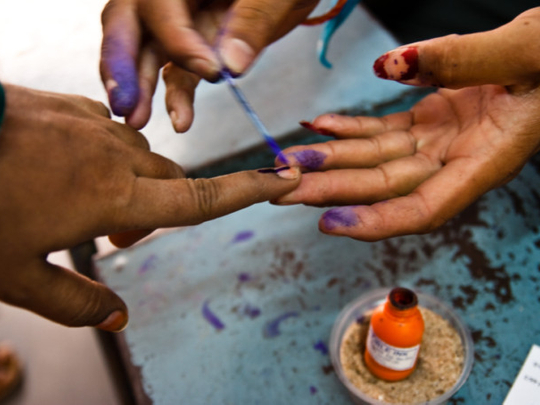
At stake is the future of the world’s largest democracy and more than 1.2 billion people. The spectacle of the Indian behemoth stirring itself and rumbling into action as its voters trudge to the poll booths is always a gripping one.
This year, however, there is a different energy and a new fervour. For the first time in decades, ordinary Indians believe they have a chance to be actively involved in the nation’s most popular spectator sport, politics.
What has fired up their imagination? A young party, just over a year old, led by a middle-class man who has taken on the entire political establishment with little money, few connections and a humble broom as an election symbol.
Arvind Kejriwal and his Aam Aadmi Party (AAP) might well make the 2014 elections a watershed moment in the republic’s history. As columnist and well-known social commentator Santosh Desai puts it, “It’s the first serious attempt by the citizenry to reclaim their stake in the process of democracy. Our democracy has increasingly become notional, geared more towards winning elections and gaining power rather than the people’s welfare.”
It was first social crusader Anna Hazare and then his protégé Arvind Kejriwal who aimed a punch at the malodorous, rotting heart of Indian politics. With its anti-corruption crusade, transparent funding, disregard for caste and religion, and willingness to welcome ordinary citizens, the AAP has got the dirty out of politics and thrown open old feudal doors to the common man. “The AAP has made a lateral entry into politics possible,” notes Dileep Padgaonkar, political observer and former editor of The Times of India.
It is a fundamental shift, one that could change the way India conducts its politics forever. “All elections are about change. What is different about these elections is that they hold out the hope of a systemic change,” points out columnist and political commentator Anil Dharker.
India’s vast taxpaying middle class now has a saviour, one who has risen from their ranks. As 46-year-old Sunita Godbole, a Mumbai activist and newly minted member of the AAP, sees it, “Until now, our politicians were VVIPS. Now they are people like us who understand our problems.” Abdul Rashid, 64, a chauffeur who can ill afford to give up his lower middle-class wages but says he’s ready to work gratis for an AAP candidate, puts it more emphatically: “All these years, we have been the politicians’ gulam (slaves). The time has come to change that.”
It is the middle class that forms a big chunk of the BJP’s prime ministerial aspirant Narendra Modi. Until the entry of the AAP, Modi, an aam aadmi (common man)who was himself once a tea vendor, held centre stage as the chief challenger to the reigning Congress. He owed much of his rise to the Congress’s scandalous levels of corruption and the policy paralysis that saw the growth rate dip, inflation shoot up and the rupee crash. Despite the 2002 communal massacre in Godhra on his watch as Chief Minster of Gujarat, Modi and his party were on a roll. It looked like 2014 would be the BJP versus Congress, Narendra Modi versus Rahul Gandhi.
This was before the storming of the citadel that was the AAP’s spectacular victory in the Delhi Assembly polls in December. Now it’s a three-way battle among three fundamentally different parties and their dramatically different leaders. It’s a Gandhi-Modi-Kejriwal fight to the finish — and India is loving it.
Middle ground
Whether this enthusiasm will be translated into votes is the big question. Will India’s middle and upper classes, notoriously lazy on voting day, participate in numbers that matter? Their votes will be key. With three big parties contesting, the results could come down to the wire.
The AAP could shake up all calculations if it can get its national act together. A conservative estimate is 15 to 20 seats. Others put the figure higher. The party is getting the numbers (membership hit 100,000 in mid-January and the target is an ambitious 100 million by January 26) but can it gather the enormous resources required? Mayank Gandhi, who heads its campaign in Mumbai, is confident: “This is the least of our problems. In Delhi we wanted Rs200 million and got it one month prior to the expected date. So we don’t envisage problems now.”
Challenging change
The other big question mark is the stability of the AAP. Cynics fear it will implode, while supporters fear it will waste precious time on the infighting in its ranks. Others believe it will be done in by what Anil Dharker calls “the arrogance of self-righteousness”.
Some members, such as Vinod Kumar Binny, are in open revolt. One of its high-profile members, Captain G.R. Gopinath, former CEO of India’s low-cost carrier Air Deccan, warns that party members down the line should “not succumb to arrogance, greed and abuse of power and go the way of all flesh”. He has been especially critical of the AAP’s move to stop foreign direct investment in retail in Delhi, a move that will not endear it to big businesses.
The brass tacks of votes and seats aside, it is undeniable that the AAP has changed the terms of political engagement in India and the old guard has had to accede reluctantly. Will it be a lasting impact? No one can tell now. But one thing is for sure, says Padgaonkar. “The people of India don’t want déjà vu politics; the same faces, same sliminess, criminality and pompousness. Because the déjà vu represents all that is wrong with the country. We want fresh faces.”
That is one result that is definitely on the cards in 2014. For India knows this is its big chance to transform the business of politics. And its future.







